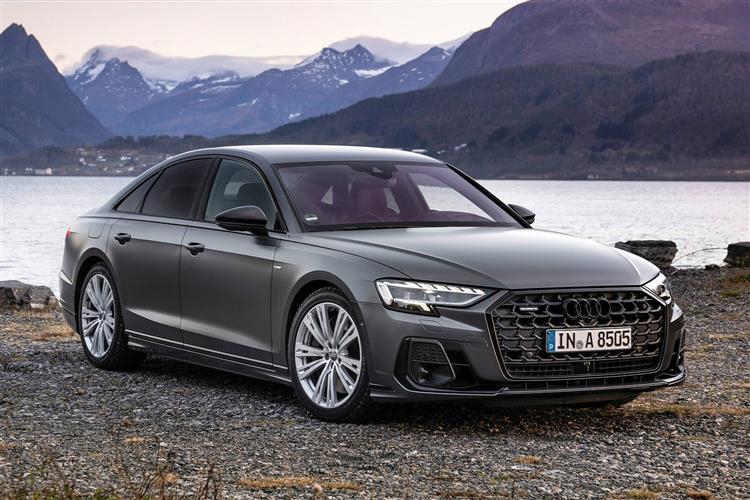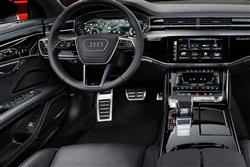GREEN WITH SHEEN (some text hidden) --NONE--
By Jonathan Crouch
Audi's A8 60 TFSI e PHEV saloon allows a successful executive to go green in some style. Jonathan Crouch looks at the revised version
Ten Second Reviewword count: 72
Audi offers PHEV technology in its largest saloon, the A8 - but at quite a price premium. Still, successful top executives may not care too much about that given that someone else will probably be paying for this, the A8 60 TFSI e quattro variant. The revised version of this model has a larger 17.9kWh battery and a smarter look. For urban chauffeuring of boadroom folk, it might be a tempting proposition.
Backgroundword count: 102
If you're buying a boardroom level large luxury saloon, and it's quite possible that you may not much care about saving the planet. But eco-friendliness has to start somewhere - and this Audi A8 TFSI e plug-in model is as good a place as any. You might be surprised to learn that plug-in technology is quite commonplace in the full-sized luxury saloon segment. Versions of the BMW 7 Series (the 745e) and the Mercedes S-Class (the S560e) have offered it for some time. Audi introduced this A8 TFSI e plug-in model only as recently as late 2019. Here, it's been usefully revised.
Driving Experienceword count: 296
Being somewhat late to the party in the PHEV part of the big luxury saloon segment, Audi has had plenty of time to check out what rivals BMW or Mercedes are offering here - and try to deliver something better. In the case of this A8 60 TFSI e, that means a 3.0-litre turbocharged V6 petrol engine with 340PS mated to an electric motor with 100KW. That means a total combined output of 462PS (itwas 449PS before), sent to all four wheels via an 8-speed tiptronic automatic gearbox. Even given the weight of this car, you might expect that to translate into a pretty potent set of performance figures - and that's how it turns out. The 62 mph sprint from rest occupies just 4.9 seconds - which is quicker than plug-in Mercedes S-Class and BMW 7 Series rivals. Top speed is limited to 155mph - but if it wasn't, you could probably crest 170mph. At the wheel, you can choose between four modes. “EV” stands for fully electric driving, “Hybrid” for an efficient combination of both drive system types, and “Hold” for conserving the available electric energy, while the combustion engine charges the battery in “Charge” mode. Of greater interest here though, is the all-electric driving range, which thanks to this revised model's larger 17.9kWh battery is now well over the 30 mile mark. But that's still way off the impressive 63 mile total you'd get from a rival (but pricier) Mercedes S560e. There's an 84mph all-electric top speed - but obviously if you regularly approach that, your battery charge won't last very long. This isn't much of a driver's car of course - it isn't intended to be. Instead, strengths include superb refinement and an exceptional quality of ride from the standard air suspension.
To see the full road test text contact us on 0330 0020 227
Pictures (high res disabled)

.jpg)
|
.jpg)
|
.jpg)
| |||
.jpg)
|

|
Statistics (subset of data only)
Min |
Max |
|
Price: |
£83,465.00 |
£87,465.00 |
Insurance group 1-50: |
48 |
|
CO2 (g/km): |
57 |
64 |
Max Speed (mph): |
155 |
|
0-62 mph (s): |
4.9 |
|
Combined Mpg: |
110.9 |
113 |
Length (mm): |
5135 |
|
Width (mm): |
1949 |
|
Height (mm): |
1460 |
|
Boot Capacity (l): |
390 |
|
Scoring (subset of scores)
Category: Hybrid, Plug-in, Electric & Hydrogen
| Performance | |
| Handling | |
| Comfort | |
| Space | |
| Styling, Build, Value, Equipment, Depreciation, Handling, Insurance and Total scores are available with our full data feed. | |



